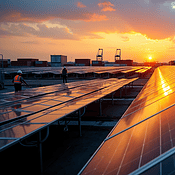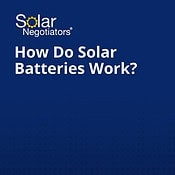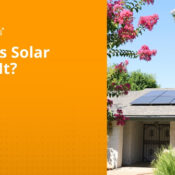
Solar Tariffs – Are They Here To Stay?
Solar Tariffs
Solar tariffs have hit America’s renewable energy sector hard. U.S. solar tariffs now reach up to 50% on photovoltaic cells, which creates major challenges for the industry. These trade measures will make solar projects 10-30% more expensive and add $0.10 to $0.30 per watt to installation costs.
We’ll explore what these changes mean for consumers and businesses. The discussion will also address whether these tariffs might become a permanent part of our renewable energy future.
Current US Solar Tariffs Explained
“Imported solar energy resources, including solar polysilicon, wafers, and cells from China are now subject to 60% tariffs under Section 301.” — Donald Trump, President of the United States
Trump has introduced new tariffs of 10% on China and 25% on Canada, while Mexico’s tariffs are delayed by a month. This raises tariffs on Chinese solar products, including cells, wafers, and polysilicon, to as high as 60%. This follows the Biden administration’s September 2024 tariff hikes, which increased solar cell tariffs from 25% to 50%, with similar increases for wafers and polysilicon taking effect in early 2025.
Nobody knows how long these tariffs will last. The Department of Energy and Commerce will watch solar module import patterns closely. Solar installation decisions become vital now, before these tariffs take full effect.
The Changing Landscape Of Solar
While the solar industry experienced remarkable growth during President Trump’s first term, tariffs act as a cornerstone of trade policy that will affect the solar panel industry in America. This leads to serious effects comprising of:
Job Losses and Investment Decline
The solar sector now faces major workforce cuts, especially in installation and development roles. The industry missed the chance to create 62,000 jobs. Installation jobs took five times more hits than manufacturing positions. Private sector investment dropped by $19 billion, which hurt project development and expansion plans.
A study on tariffs effects on the solar industry found that tariffs reduced overall welfare, as the loss in solar installation jobs outweighed gains in solar manufacturing employment. Additionally, the tariffs negatively impacted both domestic and global welfare due to environmental externalities. What was gained was a modest subsidy for U.S. solar manufacturing that could increase domestic production, stabilize employment, and improve welfare outcomes. The study suggests that industrial policies, like the Inflation Reduction Act, may be more effective than protectionist tariffs in supporting the solar industry.
Manufacturing Capacity Changes
U.S. solar manufacturing shows mixed results. Domestic module assembly has grown after Section 201 tariffs came into effect. Foreign manufacturers now use the 2.5 GW solar cell import exemption. Yet domestic production of cells and wafers keeps falling. The gap in manufacturing costs remains wide:
- Production costs in China are 55% lower than in the United States
- U.S. module prices are 43-57% higher than global averages
- Manufacturing capacity might jump from 8 GW to 62 GW each year
Installation Cost Increases
Installation costs have jumped substantially. New duties could push module costs up by 10-15 cents per watt. This affects both homes and businesses. With a large majority of solar panels coming from China, and foreign countries, tariffs are increasing the costs to get solar panels and ultimately costs are typically passed onto the consumer. Without doubt, people who want to adopt solar need to act fast. Costs will likely rise more when additional tariffs take full effect.
Amidst Uncertainty, Solar Energy Remains Strong
Despite these challenges, the solar sector has demonstrated remarkable adaptability in the past under Trump’s first term with solar installations upwards of 128% and a significant milestone of achieving 100 gigawatts of total installed solar capacity. For Trump’s second term and beyond – we expect to see continued innovation and a growing demand for renewable energy solutions.
Solar Tax Credits At Risk?
Trump’s second term might bring changes to the Investment Tax Credit (ITC). The administration has proposed eliminating green energy tax credits established under the Inflation Reduction Act (IRA), including the 30% ITC for solar installations. While it is still too early to tell, experts believe companies might need domestic manufacturing to qualify for tax credits. These policy shifts could lead to increased costs for renewable energy projects and may influence investment decisions in the clean energy sector.
These uncertain changes create an urgent need for solar adoption now.
> Call Us Today To Lock In Current Prices!
Solar technology has become more efficient and reliable than ever before. Homeowners who want solar panels should act quickly to lock in current federal incentives and avoid annual increases in electricity costs.
Conclusion
Solar tariffs have altered the map of America’s renewable energy sector. These changes led to job losses and decreased investments. Market data shows these trade restrictions will affect installation costs and might raise them by 30% after implementation.
China holds a dominant position in global solar manufacturing. They control 90% of rare earth elements and 79% of polysilicon production, which makes quick policy changes unlikely. Federal incentives still provide a 30% tax credit through 2032. These benefits could change under different administrative policies.
Delaying solar system installation could get pricey. New tariffs will likely cause a 10-30% price increase when fully implemented. This makes quick action vital for homeowners and businesses. Current pricing and available incentives need swift decisions to maximize benefits.
The solar industry faces a vital turning point. Utility rates keep rising, and new tariffs are coming. These factors build a strong economic case to adopt solar now. Talk to a solar expert today to secure current prices and shield yourself from future cost increases.
FAQs
Q1. How have solar tariffs affected the U.S. solar industry?
Solar tariffs have led to significant job losses, reduced investments, and increased installation costs. According to the Solar Energy Industries Association (SEIA), the 2018 tariffs resulted in the loss of more than 62,000 jobs and $19 billion in private sector investment, with potential solar installations dropping by 10.5 gigawatts.
Q2. How do solar tariffs impact the cost of residential solar installations?
Solar tariffs have contributed to rising installation costs. The products used in solar panels are subject to tariffs including photovoltaic cells, solar wafers and polysilicon, and tungsten products. These trade measures could make solar projects 10-30% more expensive and add $0.10 to $0.30 per watt to installation costs.
Q3. Should homeowners consider installing solar panels now or wait?
Given the projected 10-30% price increase once new tariffs are fully implemented, it’s advisable to act sooner rather than later. Installing solar now can help secure current pricing and maximize available incentives before potential changes occur.
Recent Posts
Solar Tariffs – Are They Here To Stay?
Solar Backup Solutions: How Do Solar Batteries Work?
When Is Solar Worth It
Reduce your reliance on the energy grid.
Get Solar In
Your Inbox

Refer friends and get paid in-app
The more referrals you bring in, the higher your earnings.
Earn $1,000 for each referral, and bonuses of up to $1,500 once you hit your 10th referral.





